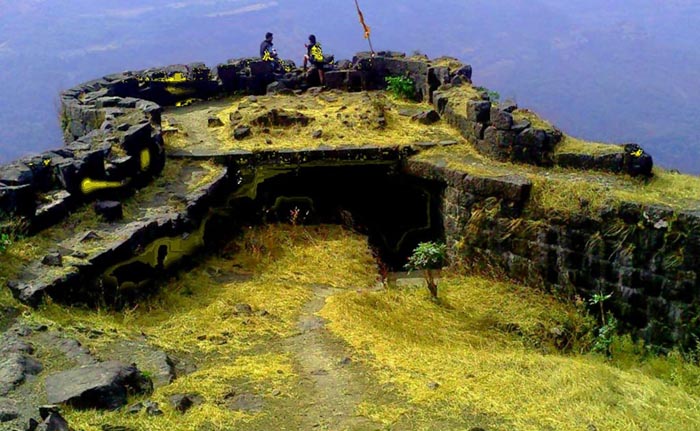Rajmachi Fort

Information on Rajmachi Fort (Pune, Maharashtra) - History & Architecture
Rajmachi Fort is the two beautiful ancient forts found in the Rajmachi Village in Maharashtra. This is a local picnic place and a famous tourist spot in Shyadri Mountain ranges in Pune. It is situated in Udhewadi Village, Lonvala Town of Pune District in Maharashtra State of India.
Rajmachi Fort Architecture
Rajmachi Fort is built over two hill stretches. They are known as the Shrivardhan hills, which is at a 3250 ft above the sea level. The Manaranjan Hill is at a 2700 ft above the sea level. These forts are built on the top plateau of these hills. This was a defensive fort on the present Lonvala and the Kandhala hill places. These two forts on the Rajmachi are well known as the Shrivardhan fort and the Manaranjan fort, locally found in the Rajmachi Peaks. Both are built in the traditional India forts form, which are found in the ancient times. It is totally a stone marvel. A very good thick fortification is laid on its top. These walls are still lasting and will last another 1000 years. Inside there are few ruined complexes are found, in ancient times this must be an important living area. The most important features found here is, it has many manmade and natural water catchment areas. Since, this zone comes under the heavy monsoon area. Many manmade lakes and ponds are built here to safeguard fresh water for the summer seasons. A few Hindu temples and Buddhist caves are built here over a passage of time. The famous Kal Bairavi Temple is built here, which is a famous among the Hindus and consider visiting this temple on some special auspicious days.
Rajmachi Fort History
Rajmachi Fort was built by the Satavahana dynasty, who established their Kingdom soon after the decline of the Mauryan Empire. They were the follower of Hinduism and ruled the Indian province peacefully from 230 BC. This kingdom lasted for five centuries thereafter. This fortress stood as a defensive fort to have a look out on the Bor Ghats. Since this is a significant route towards the west to reach Mumbai. This valley is mostly mentioned in the Indian history as an ancient route for traders. Many invaders and travelers have noted it as a very beautiful natural scenic place surrounded with meadows, hills, waterfalls, lakes and pasture lands. This fort came to light when Shivaji became the king of Marat Wad. At this time the Bijapur kingdom ruled over this area. In the year 1657 AD Shivaji fought with Adil Sha and brought this fort in his control. Under the Shivaji's rule this fort became more defensive to have a vigil over this valley. He also added few structures here for garrison purpose. In 1704 AD this fort was attacked by the Mughal's and captured this fort only or a year time. In 1705 the Marathas fought once again and defeated the Aurangzeb's military and took control over here. Later on this was handed over to Angre who were the feudal lord for Maratha Kingdom. The 19th century saw the decline of the Maratha Empire. At this time India saw the peak of colonialism. The British were able to control all India by making the local rulers as their slaves or subordinates. From 1818 AD this was under the British-India rule. After India's independence this fort was announced as ancient heritage place and a protected monument in Maharashtra.
Rajmachi Fort Tourism Significance
Rajmachi Fort is now a famous trekking place and a holiday destination for the Maharashtrians. It also pull international tourist now, who seeks eco friendly tourism in India. It will be a pride to visit this ancient fort, which was built in 230 BC. It is the best place for history, nature and fort lovers. Apart from the historical and architectural brilliance, it would be a lifetime experience to witness the beauty of the fort as along with it, one would surely fall in love with the nature and the surrounding in which the fort is situated. The beauty of the fort and the nature has perfectly settled respecting the important of one another to entertain those who visit the fort here in Pune district in Maharashtra.
- Ahmednagar Monuments
- Akola Monuments
- Amravati Monuments
- Aurangabad Monuments
- Dhule Monuments
- Kolhapur Monuments
- Latur Monuments
- Mumbai Monuments
- Nagpur Monuments
- Nashik Monuments
- Palghar Monuments
- Pune Monuments
- Raigad Monuments
- Ratanagiri Monuments
- Satara Monuments
- Sindhudurg Monuments
- Thane Monuments
- Andaman Nicobar Monuments
- Andhra Pradesh Monuments
- Assam Monuments
- Bihar Monuments
- Chhattisgarh Monuments
- New Delhi Monuments
- Goa Monuments
- Gujarat Monuments
- Haryana Monuments
- Himachal Pradesh Monuments
- Jammu and Kashmir Monuments
- Karnataka Monuments
- Kerala Monuments
- Madhya Pradesh Monuments
- Maharashtra Monuments
- Odisha Monuments
- Punjab Monuments
- Rajasthan Monuments
- Tamil Nadu Monuments
- Telangana Monuments
- Uttar Pradesh Monuments
- West Bengal Monuments